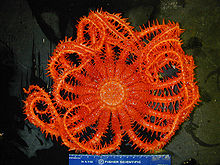Brisingida
| Brisingida | |
|---|---|

| |
| Brisingid sea star | |
| Scientific classification | |
| Kingdom: | |
| Phylum: | |
| Subphylum: | |
| Class: | |
| Order: | Brisingida Fisher, 1928
|
| Families | |
|
see text | |
The Brisingida are an order of deep-sea-dwelling sea stars.[1][2]
Description
These starfish have between six and 16 long, attenuated arms which they use for suspension feeding.[3] Other characteristics include a single series of marginals, a fused ring of disc plates, the lack of actinal plates, a spool-like ambulacral column, reduced abactinal plates, and crossed pedicellariae.[4]
Distribution
Brisingida occur in a number of deep-sea locations, particularly in the Caribbean and New Zealand.[5]

Taxonomy
The Brisingida contain two families, with 18 genera:[2]
- Family Brisingidae, G.O. Sars, 1875[6]
- Genus Astrolirus, Fisher, 1917 — (monotypic)
- Genus Astrostephane, Fisher, 1917 — (two species)
- Genus Brisinga Asbjørnsen, 1856 (synonym: Craterobrisinga, Fisher, 1916) — (20 species)
- Genus Brisingaster Loriol, 1883 — (monotypic)
- Genus Brisingella Fisher, 1917 — (monotypic)
- Genus Brisingenes Fisher, 1917 — (four species)
- Genus Hymenodiscus Perrier, 1884 — (16 species)
- Genus Labidiaster, Lütken, 1872 (synonym: Gymnobrisinga, Studer, 1884)
- Genus Midgardia Downey, 1972 — (monotypic)
- Genus Novodinia Dartnall, Pawson, Pope & B.J. Smith, 1969 (synonym: Odinia, Perrier, 1885) — (13 species)
- Genus Odinella Fisher, 1940 — (monotypic)
- Genus Stegnobrisinga Fisher, 1916 — (three species)
- Family Freyellidae, Downey, 1986[7][8]
- Genus Astrocles Fisher, 1917 — (three species)
- Genus Belgicella Ludwig, 1903 — (monotypic)
- Genus Colpaster Sladen, 1889 — (two species)
- Genus Freyastera Downey, 1986 — (six species)
- Genus Freyella Perrier, 1885 (synonym: Freyellidea, Fisher, 1917) — (31 species)
- Genus Freyellaster Fisher 1918 — (five species)
Further reading
- Hansson, H.G. (2001). Echinodermata, in: Costello, M.J. et al. (Ed.) (2001). European register of marine species: a check-list of the marine species in Europe and a bibliography of guides to their identification. Collection Patrimoines Naturels, 50: pp. 336–351 (look up in IMIS) [details]
- Clark, A.M. and M.E. Downey. (1992). Starfishes of the Atlantic. Chapman & Hall Identification Guides, 3. Chapman & Hall: London, UK. ISBN 0-412-43280-3. xxvi, 794 pp. (look up in IMIS) [details]
- Downey. M.E. (1986). Revision of the Atlantic Brisingida (Echinodermata: Asteroidea), with description of a new genus and family. Smithsonian Contributions to Zoology No.435. 57pp. [details]
- Fisher, W.K. (1917). New genera and species of Brisingidae. Annals and Magazine of Natural History 20(8): 418-431. [details]
- Sladen, W.P. (1889). Report on the Asteroidea. Report on the Scientific Results of the Voyage of H.M.S. Challenger during the years 1873-1876, Zoology 30(51): xlii + 893 pages 118 plates. [details]
- Clark, A.M.and Mah, C. (2001). An index of names of recent Asteroidea, part 4. Forcipulatida and Brisingida, in: Jangoux, M.; Lawrence, J.M. (Ed.) (2001). Echinoderm Studies, 6: pp. 229–347 (look up in IMIS) [details]
References
- ^ "Asteroidea". Tolweb.org. 2004-10-07. Retrieved 2010-07-30.
- ^ a b "WoRMS - World Register of Marine Species - Brisingida". Marinespecies.org. Retrieved 2010-07-30.
- ^ "Asterozoa: Fossil groups: SciComms 05-06: Earth Sciences". Palaeo.gly.bris.ac.uk. 2005-11-22. Retrieved 2010-07-30.
- ^ Revision of the Atlantic Brisingida (Echinodermata: Asteroidea), with Description of a New Genus and Family
- ^ "Data Use Agreement - GBIF Portal". Gbif.net. 2007-02-22. Retrieved 2010-07-30.
- ^ "The World Asteroidea Database - Brisingidae". Marinespecies.org. Retrieved 2010-07-30.
- ^ "Antarctic Invertebrates: Brisingida". Invertebrates.si.edu. 1970-01-01. Retrieved 2010-07-30.
- ^ "The World Asteroidea Database - Freyellidae". Marinespecies.org. Retrieved 2010-07-30.
